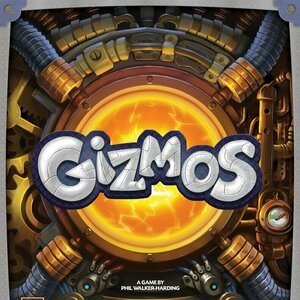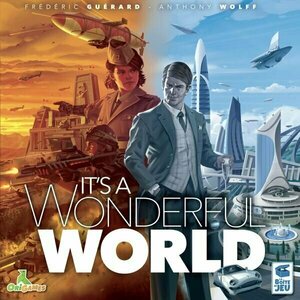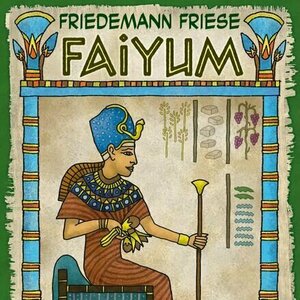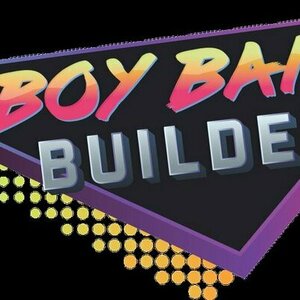Search

SuperTactics
Games
App
□ The beginning of strategy - Tech tree system Will you give up just because your opponent's deck...

Guide & Strategies for Clash Royale - Deck Share Community
Reference and Utilities
App
Welcome to the #1 Clash Royale Community for Strategies & Deck Sharing! A new way to Share,...

Mob Sitters
Tabletop Game
Earn a fortune in babysitting's toughest job! Mob Sitters is a party game for 3-8 players where...

The Sweetheart Quest (Sweetheart Escapes)
Book
Finding out my blind date is one of my gamer friends? Awesome. Finding out he’s also my boss? Kill...
Contemporary MM Romance
Purple Phoenix Games (2266 KP) rated Gizmos in Tabletop Games
Apr 20, 2021
I have absolutely never been very good at science. At least not in school. So when I started reading the rule for Gizmos and found out it was set at a science fair I thought I was doomed. Well, turns out you don’t really need to know anything about science to enjoy this one or be decent at playing. So if you are like me and don’t remember anything besides the Mitochondria is the powerhouse of the cell, then read on about a great game called Gizmos.
Gizmos is a card drafting, energy collecting, engine building game about, well, building engines. Players will be attempting to draft machine parts from an offer pyramid and build them onto their master jalopy machine using energy marbles in order to chain actions together and maximize their turns. The victorious player is they that claims the most VP from cards and bonus VP tokens at the end of the game.
To setup, assemble the energy dispenser (the marble gumball machine looking component) and place it on the table. Fill it with all the marbles and marvel at the first six that come out into a chute display. Separate and shuffle the card decks by their backs and set out four cards of level I, three cards of level II and two cards of level III. Determine starting player and give them the starting tableau board. Each player will receive a tableau board, an energy ring, and a starting gizmo to be placed under the File section of their board. The game may now begin!
On a player’s turn they will be completing one action from the four actions printed on their player board: File, Pick, Build, and Research. The File action is used when a player chooses a card from the gizmo pyramid (from any level) and places it in their Archive – an imaginary area to the right (or even above I’ve found) their player board. At the beginning of the game players will be able to hold just one gizmo in their Archive, but as they draft and build Upgrades, this number can increase. When choosing the Pick action, the player will simply choose one of the energy marbles from the dispenser chute and place them in their energy ring. Initially rings are only able to hold five marbles, but this also can be increased on future builds. To Build a gizmo into a player’s machine, the player will spend a specific color and number of energy marbles printed on the chosen gizmo card to place the card into their player tableau. These gizmos could possibly be Upgrades, energy Converters, or upgrades to the File, Pick, and Build actions. Pay the energy marble to the dispenser supply. Players will choose to Research when they do not like the gizmos on display in the gizmo pyramid. Researching allows players to draw the top cards from any face-down level deck and choose one to either File or Build.
The game is super simple to this point, but this is where the true strategy and tactics come into play. Though there will always be nine gizmos on display during a player’s turn, the value of these gizmos are in how they are used in the player tableau. Yes each gizmo allows for some benefit, but successful players will be able to utilize these benefits to create chain reactions. When an action is spent to do a thing, gizmos in play in the tableau will sometimes link to the action, or to the placement of a certain type of card, or a certain energy type (color) of gizmo built. It is mastering these chain reactions that creates next-level strategizing and separates the players from the champions. Play continues on in this fashion until a player has built their fourth level III gizmo or their 16th gizmo in total. Count up VP from built gizmos and bonus tokens earned from built gizmos throughout the game to see who wins the science fair (is that what happens at science fairs? People win those, right?)!
Components. So the gizmo cards are fine, and the cardboard components are fine as well. The marbles are interesting and bubbled plastic (or resin, I told you I’m not great at science) and come in great colors. The true star component here is that energy marble dispenser. It is absolutely brilliant. The game comes with assembly instructions, thankfully, but once it’s built, it’s built forever. It packs neatly back into the box, and the insert is very very well done. The artwork on this is surprisingly secondary to me. In fact, I don’t really remember even looking at much of the artwork on the gizmo cards as I was playing because I concentrate so much more on the effects of the gizmos and trying to figure out my next move to really sit and gawk at the art. The iconography takes a little time to get used to, but once you have seen it in action for a few rounds, you catch on quickly. All in all, a fine set of components, but with the insert and dispenser, now a great set of components.
I adore this game! I love engine builders, and the chain reactions you can create with your gizmos are excellent and can be very powerful. You can try to generate tons of bonus VP from your gizmos, or concentrate on versatile energy marbles using a bunch of Converters, or simply go guns blazing on everything you can afford to try to blitz to 16 gizmos built. Whatever your play style, Gizmos can certainly allow you to play your way while giving you choices upon choices to make each turn.
With all these positives, I had to find a negative, right? Well, ok, yes, but it’s super minor to me here. I don’t really feel like the theme is very immersive. Not once have I felt like I am building a machine in order to win a science fair, but I do feel like I need to maximize my turn every time in order to grab more energy, or to build better Upgrades and Converters so I can grab any gizmo I want and build it right away. So, theme is there, but not at all strong.
Though the theme is just okay, the game play certainly is stellar. This one has everything I like in an engine building game, and has unique and interesting components. Would I like it more if the theme was different. I doubt it. The game play is just so good that the theme and artwork takes a back seat for me, and that’s super weird for me to type. Should you be looking for a great engine building game that looks awesome on the table, has cool components, and allows you to play differently every game, then go find yourself a copy of Gizmos. Purple Phoenix Games gives it an energetic 21 / 24. Now if only my 4-year-old could keep the energy marbles in the chute or the ring and not on the floor…
Gizmos is a card drafting, energy collecting, engine building game about, well, building engines. Players will be attempting to draft machine parts from an offer pyramid and build them onto their master jalopy machine using energy marbles in order to chain actions together and maximize their turns. The victorious player is they that claims the most VP from cards and bonus VP tokens at the end of the game.
To setup, assemble the energy dispenser (the marble gumball machine looking component) and place it on the table. Fill it with all the marbles and marvel at the first six that come out into a chute display. Separate and shuffle the card decks by their backs and set out four cards of level I, three cards of level II and two cards of level III. Determine starting player and give them the starting tableau board. Each player will receive a tableau board, an energy ring, and a starting gizmo to be placed under the File section of their board. The game may now begin!
On a player’s turn they will be completing one action from the four actions printed on their player board: File, Pick, Build, and Research. The File action is used when a player chooses a card from the gizmo pyramid (from any level) and places it in their Archive – an imaginary area to the right (or even above I’ve found) their player board. At the beginning of the game players will be able to hold just one gizmo in their Archive, but as they draft and build Upgrades, this number can increase. When choosing the Pick action, the player will simply choose one of the energy marbles from the dispenser chute and place them in their energy ring. Initially rings are only able to hold five marbles, but this also can be increased on future builds. To Build a gizmo into a player’s machine, the player will spend a specific color and number of energy marbles printed on the chosen gizmo card to place the card into their player tableau. These gizmos could possibly be Upgrades, energy Converters, or upgrades to the File, Pick, and Build actions. Pay the energy marble to the dispenser supply. Players will choose to Research when they do not like the gizmos on display in the gizmo pyramid. Researching allows players to draw the top cards from any face-down level deck and choose one to either File or Build.
The game is super simple to this point, but this is where the true strategy and tactics come into play. Though there will always be nine gizmos on display during a player’s turn, the value of these gizmos are in how they are used in the player tableau. Yes each gizmo allows for some benefit, but successful players will be able to utilize these benefits to create chain reactions. When an action is spent to do a thing, gizmos in play in the tableau will sometimes link to the action, or to the placement of a certain type of card, or a certain energy type (color) of gizmo built. It is mastering these chain reactions that creates next-level strategizing and separates the players from the champions. Play continues on in this fashion until a player has built their fourth level III gizmo or their 16th gizmo in total. Count up VP from built gizmos and bonus tokens earned from built gizmos throughout the game to see who wins the science fair (is that what happens at science fairs? People win those, right?)!
Components. So the gizmo cards are fine, and the cardboard components are fine as well. The marbles are interesting and bubbled plastic (or resin, I told you I’m not great at science) and come in great colors. The true star component here is that energy marble dispenser. It is absolutely brilliant. The game comes with assembly instructions, thankfully, but once it’s built, it’s built forever. It packs neatly back into the box, and the insert is very very well done. The artwork on this is surprisingly secondary to me. In fact, I don’t really remember even looking at much of the artwork on the gizmo cards as I was playing because I concentrate so much more on the effects of the gizmos and trying to figure out my next move to really sit and gawk at the art. The iconography takes a little time to get used to, but once you have seen it in action for a few rounds, you catch on quickly. All in all, a fine set of components, but with the insert and dispenser, now a great set of components.
I adore this game! I love engine builders, and the chain reactions you can create with your gizmos are excellent and can be very powerful. You can try to generate tons of bonus VP from your gizmos, or concentrate on versatile energy marbles using a bunch of Converters, or simply go guns blazing on everything you can afford to try to blitz to 16 gizmos built. Whatever your play style, Gizmos can certainly allow you to play your way while giving you choices upon choices to make each turn.
With all these positives, I had to find a negative, right? Well, ok, yes, but it’s super minor to me here. I don’t really feel like the theme is very immersive. Not once have I felt like I am building a machine in order to win a science fair, but I do feel like I need to maximize my turn every time in order to grab more energy, or to build better Upgrades and Converters so I can grab any gizmo I want and build it right away. So, theme is there, but not at all strong.
Though the theme is just okay, the game play certainly is stellar. This one has everything I like in an engine building game, and has unique and interesting components. Would I like it more if the theme was different. I doubt it. The game play is just so good that the theme and artwork takes a back seat for me, and that’s super weird for me to type. Should you be looking for a great engine building game that looks awesome on the table, has cool components, and allows you to play differently every game, then go find yourself a copy of Gizmos. Purple Phoenix Games gives it an energetic 21 / 24. Now if only my 4-year-old could keep the energy marbles in the chute or the ring and not on the floor…
Purple Phoenix Games (2266 KP) rated It's a Wonderful World in Tabletop Games
Oct 30, 2021
When choosing board games to either play or purchase, how much importance should one put on box cover art? It is important to ME, but I lump that all in with the components and art/art style of the whole package. Why do I bring this up in the intro today? Well, I have to admit that I had really not had any interest in checking out It’s a Wonderful World until now because I judged the game by its cover, and the cover art told my brain that this would be some type of wargame. I am not entirely sure how I connected the two, but I did, and it turned me off right away. But! I was able to get this played at a local board game lounge, and boy was I wrong.
It’s a Wonderful World is a card drafting, economic, civilization building game with variable player powers (with a dash of campaign mode sprinkled on top). In it, players are attempting to build their civilization faster and better than their competitors. However, for this review, I will be playing the vanilla non-scenario solo mode.
DISCLAIMER: I was able to play this and several other games at The Table in Cookeville, TN. If you are ever in the neighborhood, check them out, and tell Nathaniel that I say hello.
To setup, put together the main board and place the round marker on Round 1. Lay out all the resources on their specific places upon the board and shuffle the deck of cards. Deal out eight stacks of five cards each and place them as mini-decks somewhere on the table. Choose a starting civilization (or just randomly choose one). The solo game is ready to play!
Typically, It’s a Wonderful World is a card drafting game, a la 7 Wonders, where players choose one card from the deck passed to them and pass it along to the next player until all cards have been drafted. In the solo mode, however, the player chooses one of the face-down mini-decks as their starting hand. Upon viewing the cards, the player may choose to place any or all of them in their Construction Area, or discard the cards for their Recycle Bonus (typically a type of resource), and/or discard two card from the mini-deck to draw five cards from the top of the main deck. From these drawn cards, the player may choose one to keep and discard all others. The kept card may be placed into the Construction Area or discarded for its Recycle Bonus resource.
Cards placed in the Construction Area require resources to be earned and placed on them in order to complete its build process. Each round the player will receive resources based on which cards have been built and placed above their starting civ card. Some cards, once completely built, will also offer more VP at game end, or supply a VP modifier.
After the first mini-deck has been played completely, the player will choose a second mini-deck and run through the same process. After this second mini-deck has been completed the round ends and play moves to the next round. Play continues in this fashion until all four rounds have been played (so all eight mini-decks). At game end the player counts up all their VP and compares it to the table in the rulebook to arrive at their final tier. My first game resulted in the rulebook calling me a Rooky. So be prepared to be humiliated by a rulebook.
Components. Aside from being bamboozled by the aggressive artwork on the cover, this is not a wargame. In fact, I very much like the artwork and the styling of this game. The cards are all laid out very well, and the iconography makes sense. The resource cubes are translucent colored (except the grayish white is opaque) and are fine quality. Overall the components are great and the art style has grown on me quite a bit.
I can see why so many people compare this to 7 Wonders. Essentially, the multiplayer game is quite similar. Card drafts (of 7 cards, no less) lead to needing resources in order to build, lead to being able to produce more resources to fuel other cards, and bonus points are awarded for having a nice card profile. Now, this being a solo review, I have to say that I much prefer It’s a Wonderful World to its forefather 7 Wonders because it comes packaged with a solo mode already in the box. This isn’t the only reason I prefer it, though. I find it easier to pick up and easier to teach to beginning gamers. Also, there is no card chaining, which seems to be a difficult concept for newer gamers to grasp initially. It’s a Wonderful World has nothing like this, and cards just work. 7 Wonders has been such a hit with my family, and I know they will greatly appreciate a more streamlined game experience with this one.
So here’s my recommendation with this one. If you are a fan of 7 Wonders but find it to be difficult to get others into it, check out It’s a Wonderful World. I feel that it is superior in many ways, and the solo mode is just icing. The solo mode gives me a great play experience, even though I typically am not a fan of games challenging you to beat your own high score. I will live with it here because the game is just so enjoyable. While 7 Wonders was my favorite game of all time for quite a while, it has since dropped out of my Top 10, and I think will be replaced entirely by It’s a Wonderful World. If your tastes are similar to mine, then do yourself a big favor and grab a copy of this one right away. It has several expansions out there, and I believe you will fall in love with drafting again. Now, where did I put my Wind Turbines…
It’s a Wonderful World is a card drafting, economic, civilization building game with variable player powers (with a dash of campaign mode sprinkled on top). In it, players are attempting to build their civilization faster and better than their competitors. However, for this review, I will be playing the vanilla non-scenario solo mode.
DISCLAIMER: I was able to play this and several other games at The Table in Cookeville, TN. If you are ever in the neighborhood, check them out, and tell Nathaniel that I say hello.
To setup, put together the main board and place the round marker on Round 1. Lay out all the resources on their specific places upon the board and shuffle the deck of cards. Deal out eight stacks of five cards each and place them as mini-decks somewhere on the table. Choose a starting civilization (or just randomly choose one). The solo game is ready to play!
Typically, It’s a Wonderful World is a card drafting game, a la 7 Wonders, where players choose one card from the deck passed to them and pass it along to the next player until all cards have been drafted. In the solo mode, however, the player chooses one of the face-down mini-decks as their starting hand. Upon viewing the cards, the player may choose to place any or all of them in their Construction Area, or discard the cards for their Recycle Bonus (typically a type of resource), and/or discard two card from the mini-deck to draw five cards from the top of the main deck. From these drawn cards, the player may choose one to keep and discard all others. The kept card may be placed into the Construction Area or discarded for its Recycle Bonus resource.
Cards placed in the Construction Area require resources to be earned and placed on them in order to complete its build process. Each round the player will receive resources based on which cards have been built and placed above their starting civ card. Some cards, once completely built, will also offer more VP at game end, or supply a VP modifier.
After the first mini-deck has been played completely, the player will choose a second mini-deck and run through the same process. After this second mini-deck has been completed the round ends and play moves to the next round. Play continues in this fashion until all four rounds have been played (so all eight mini-decks). At game end the player counts up all their VP and compares it to the table in the rulebook to arrive at their final tier. My first game resulted in the rulebook calling me a Rooky. So be prepared to be humiliated by a rulebook.
Components. Aside from being bamboozled by the aggressive artwork on the cover, this is not a wargame. In fact, I very much like the artwork and the styling of this game. The cards are all laid out very well, and the iconography makes sense. The resource cubes are translucent colored (except the grayish white is opaque) and are fine quality. Overall the components are great and the art style has grown on me quite a bit.
I can see why so many people compare this to 7 Wonders. Essentially, the multiplayer game is quite similar. Card drafts (of 7 cards, no less) lead to needing resources in order to build, lead to being able to produce more resources to fuel other cards, and bonus points are awarded for having a nice card profile. Now, this being a solo review, I have to say that I much prefer It’s a Wonderful World to its forefather 7 Wonders because it comes packaged with a solo mode already in the box. This isn’t the only reason I prefer it, though. I find it easier to pick up and easier to teach to beginning gamers. Also, there is no card chaining, which seems to be a difficult concept for newer gamers to grasp initially. It’s a Wonderful World has nothing like this, and cards just work. 7 Wonders has been such a hit with my family, and I know they will greatly appreciate a more streamlined game experience with this one.
So here’s my recommendation with this one. If you are a fan of 7 Wonders but find it to be difficult to get others into it, check out It’s a Wonderful World. I feel that it is superior in many ways, and the solo mode is just icing. The solo mode gives me a great play experience, even though I typically am not a fan of games challenging you to beat your own high score. I will live with it here because the game is just so enjoyable. While 7 Wonders was my favorite game of all time for quite a while, it has since dropped out of my Top 10, and I think will be replaced entirely by It’s a Wonderful World. If your tastes are similar to mine, then do yourself a big favor and grab a copy of this one right away. It has several expansions out there, and I believe you will fall in love with drafting again. Now, where did I put my Wind Turbines…
Purple Phoenix Games (2266 KP) rated Boy Band Builder: The Card Game in Tabletop Games
Dec 21, 2021
When researching and requesting games to review and preview, I sometimes need to clarify my stance on certain things. Perhaps my thoughts on climate change, or my interest in European door decorations, or, in this case, my preferences on the era of boy bands past which we recently (and thankfully) have evolved. I was assured that my distaste for the music genre would not negatively influence my enjoyment of this game. After my plays, I must agree.
Boy Band Builder (BBB from here out) is a card drafting and band-building game for two to four players. In it, players are band managers tasked with creating the next big group of talented and attractive boys, with the winner of the game being they who earn the most money from assembling the best band and playing the most lucrative gigs.
DISCLAIMER: We were provided a copy of this game for the purposes of this review. This is a retail copy of the game, so what you see in these photos is exactly what would be received in your box. I do not intend to cover every single rule included in the rulebook, but will describe the overall game flow and major rule set so that our readers may get a sense of how the game plays. For more in depth rules, you may purchase a copy online or from your FLGS. -T
To setup, separate the cards by type and shuffle each stack independently. The Gigs deck is placed on the table with four Gigs displayed from the top of the deck. The Artists and Star decks are placed on the table and each player is dealt three Star cards to start the game. It is now setup and managers are ready to build bands… of boys!
BBB is played over a series of rounds, where each player will take two actions each turn. These actions are Audition, Draw Star Cards, Play a Star Card, and Do a Gig. When a manager Auditions boys for the band, they draw the top three Artist cards, choose one to add to their band, and then discard the rest to the bottom of the deck. The cost to add the boy to the band is shown in the upper right hand corner and represents the number of Star cards to be discarded from hand. Artists are added to band (tableau) and ready to begin rehearsing. At least, I hope they are rehearsing.
Additionally, the active manager may Draw Star Cards to increase their hand. Simply draw two Star cards from the top of the deck. Alternatively, the manager may choose to Play a Star Card for its stats by slipping the card under a boy to increase his level of Pipes, Moves, Heat, or Cool stats (check out the photo below where I went hard on buffing Old Frank).
Finally, if the boy band members currently possess the appropriate amount of stats, the manager may choose to Do a Gig. They choose one of the face-up Gigs cards, take it to their score pile (assuming they possess the correct type and number of stats), and then do a little dance to celebrate a completed Gig. To signify the end of their turn, the active manager draws a Star card and passes to the next player. The game ends once the appropriate number of Gigs have been completed by a manager, as detailed in the rules per number of players. The manager with the highest total of money earned from Gigs cards is the winner, and receives all the Grammy nominations afforded to them.
Components. This is a bunch of cards in a tuckbox. The cards are all fine, but the true hero here is the artwork. I cannot express how much I appreciate the decision to keep the art style modern, and the faces blank. I believe it is mostly due to the fact that all of us who were not in boy bands were all a bit jealous of those who were, but I will publicly state that my official opinion is because these boys don’t really need faces. Body language speaks volumes, and the art style reflects that extremely well. Mad props from me on the artwork.
The gameplay here is very intuitive, even though I had a couple questions that were not made clear in the rulebook. You need Star cards in order to buff Boys so they can do Gigs, and making sure that your band has all the right stats to complete the more profitable Gigs. I believe the game lasts an appropriate amount of time; it does NOT overstay its welcome, which is a huge thing for a filler game such as this. I do wish there were more off-the-wall characters like Old Frank and Lil’Hop, and I also wish the Star cards’ backgrounds were a little more interesting to look at, but the game ultimately looks good and plays well too. There are a few extra surprises to be found in the game that I will let our readers discover, including some Take That card that can hinder opponents.
Boy Band Builder can be super quick and competitive, or can be more leisurely and relaxed. This is a great thing for a cute little card game, and though the theme is something with which I am not at all enamored, a love for boy bands is not required to enjoy Boy Band Builder. I can see myself breaking this out with the right people, but I don’t necessarily foresee having this on stand-by for every game night. If you are in the market for a uniquely-themed card game you can chair dance while playing, then check out Boy Band Builder. It can be found on the Amazon store by clicking this link. Enjoy!
Boy Band Builder (BBB from here out) is a card drafting and band-building game for two to four players. In it, players are band managers tasked with creating the next big group of talented and attractive boys, with the winner of the game being they who earn the most money from assembling the best band and playing the most lucrative gigs.
DISCLAIMER: We were provided a copy of this game for the purposes of this review. This is a retail copy of the game, so what you see in these photos is exactly what would be received in your box. I do not intend to cover every single rule included in the rulebook, but will describe the overall game flow and major rule set so that our readers may get a sense of how the game plays. For more in depth rules, you may purchase a copy online or from your FLGS. -T
To setup, separate the cards by type and shuffle each stack independently. The Gigs deck is placed on the table with four Gigs displayed from the top of the deck. The Artists and Star decks are placed on the table and each player is dealt three Star cards to start the game. It is now setup and managers are ready to build bands… of boys!
BBB is played over a series of rounds, where each player will take two actions each turn. These actions are Audition, Draw Star Cards, Play a Star Card, and Do a Gig. When a manager Auditions boys for the band, they draw the top three Artist cards, choose one to add to their band, and then discard the rest to the bottom of the deck. The cost to add the boy to the band is shown in the upper right hand corner and represents the number of Star cards to be discarded from hand. Artists are added to band (tableau) and ready to begin rehearsing. At least, I hope they are rehearsing.
Additionally, the active manager may Draw Star Cards to increase their hand. Simply draw two Star cards from the top of the deck. Alternatively, the manager may choose to Play a Star Card for its stats by slipping the card under a boy to increase his level of Pipes, Moves, Heat, or Cool stats (check out the photo below where I went hard on buffing Old Frank).
Finally, if the boy band members currently possess the appropriate amount of stats, the manager may choose to Do a Gig. They choose one of the face-up Gigs cards, take it to their score pile (assuming they possess the correct type and number of stats), and then do a little dance to celebrate a completed Gig. To signify the end of their turn, the active manager draws a Star card and passes to the next player. The game ends once the appropriate number of Gigs have been completed by a manager, as detailed in the rules per number of players. The manager with the highest total of money earned from Gigs cards is the winner, and receives all the Grammy nominations afforded to them.
Components. This is a bunch of cards in a tuckbox. The cards are all fine, but the true hero here is the artwork. I cannot express how much I appreciate the decision to keep the art style modern, and the faces blank. I believe it is mostly due to the fact that all of us who were not in boy bands were all a bit jealous of those who were, but I will publicly state that my official opinion is because these boys don’t really need faces. Body language speaks volumes, and the art style reflects that extremely well. Mad props from me on the artwork.
The gameplay here is very intuitive, even though I had a couple questions that were not made clear in the rulebook. You need Star cards in order to buff Boys so they can do Gigs, and making sure that your band has all the right stats to complete the more profitable Gigs. I believe the game lasts an appropriate amount of time; it does NOT overstay its welcome, which is a huge thing for a filler game such as this. I do wish there were more off-the-wall characters like Old Frank and Lil’Hop, and I also wish the Star cards’ backgrounds were a little more interesting to look at, but the game ultimately looks good and plays well too. There are a few extra surprises to be found in the game that I will let our readers discover, including some Take That card that can hinder opponents.
Boy Band Builder can be super quick and competitive, or can be more leisurely and relaxed. This is a great thing for a cute little card game, and though the theme is something with which I am not at all enamored, a love for boy bands is not required to enjoy Boy Band Builder. I can see myself breaking this out with the right people, but I don’t necessarily foresee having this on stand-by for every game night. If you are in the market for a uniquely-themed card game you can chair dance while playing, then check out Boy Band Builder. It can be found on the Amazon store by clicking this link. Enjoy!





